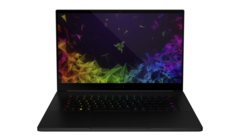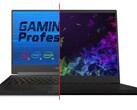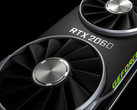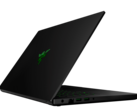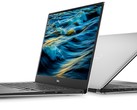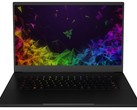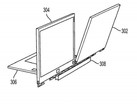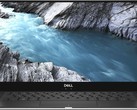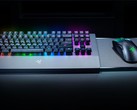Two laptops with identical processors and graphics don't necessarily have to perform the same. The system with the superior cooling solution can generally run the processor at faster clock rates than the other for slightly higher overall performance. The recent Alienware m15 and Razer Blade 15 gaming laptops exemplify this dichotomy best.
For our example here, we're comparing the aforementioned 15.6-inch Dell and Razer laptops each equipped with the same Core i7-8750H CPU and GeForce GTX 1070 Max-Q GPU. The processor in the Dell, however, is almost 25 percent faster in multi-threaded loads even after long periods of repeated CineBench stress as shown by our graph below. The CPU advantage carries over to PCMark 10 scores as well where the Dell system is consistently ahead of Razer.
The wide performance difference can be explained by the slower CPU clock rates on the Razer. When subjected to high CPU stress, its processor stabilizes at just 2.8 GHz compared to 3.5 to 3.6 GHz on the Alienware laptop. Interestingly, CPU temperature is lower on the Razer at 65 C compared to 80 C on the Alienware when under similar conditions. This suggests that the Razer Blade 15 may be capable of closing in the performance gap between the two laptops albeit at the expense of warmer surface temperatures and components. We can only assume that Razer decided against higher Turbo Boost performance during its internal testing due to temperature and stability consequences in other areas of the laptop.
GPU performance is otherwise very nearly the same between both laptops. Since most games are GPU bound rather than CPU bound, the slower processor in the Razer impacts gaming performance only marginally at worst.
The Blade 15 still has two significant advantages over the Alienware m15. It's noticeably smaller in all three dimensions and its smooth unibody matte metal design contrasts the glossy non-unibody look of the Dell equivalent. Furthermore, Razer displays tend to be more color accurate out of the box to better appeal to artists or editors.
See our full reviews on the Dell Alienware m15 and Razer Blade 15 below for more information and comparisons between these super-thin gaming laptops.
| Cinebench R15 | |
| CPU Single 64Bit | |
| Razer Blade 15 2018 | |
| Alienware m15 GTX 1070 Max-Q | |
| CPU Multi 64Bit | |
| Alienware m15 GTX 1070 Max-Q | |
| Razer Blade 15 2018 | |
| PCMark 10 | |
| Score | |
| Alienware m15 GTX 1070 Max-Q | |
| Razer Blade 15 2018 | |
| Essentials | |
| Alienware m15 GTX 1070 Max-Q | |
| Razer Blade 15 2018 | |
| Productivity | |
| Alienware m15 GTX 1070 Max-Q | |
| Razer Blade 15 2018 | |
| Digital Content Creation | |
| Alienware m15 GTX 1070 Max-Q | |
| Razer Blade 15 2018 | |
| 3DMark - 1920x1080 Fire Strike Graphics | |
| Alienware m15 GTX 1070 Max-Q | |
| Razer Blade 15 2018 | |
| Alienware m15 GTX 1070 Max-Q AU Optronics B156HAN, IPS, 15.60, 1920x1080 | Razer Blade 15 2018 LGD05C0, IPS, 15.60, 1920x1080 | |
|---|---|---|
| Display | ||
| Display P3 Coverage | 63.5 | 64.3 |
| sRGB Coverage | 89.4 | 93.7 |
| AdobeRGB 1998 Coverage | 64.5 | 65.5 |
| Response Times | ||
| Response Time Grey 50% / Grey 80% * | 18 ? | 17.2 ? |
| Response Time Black / White * | 12 ? | 12 ? |
| PWM Frequency | ||
| Screen | ||
| Brightness middle | 353.6 | 290 |
| Brightness | 346 | 281 |
| Brightness Distribution | 86 | 82 |
| Black Level * | 0.3 | 0.3 |
| Contrast | 1179 | 967 |
| Colorchecker dE 2000 * | 4.55 | 2.85 |
| Colorchecker dE 2000 max. * | 7.91 | 6.27 |
| Colorchecker dE 2000 calibrated * | 3.37 | 1.39 |
| Greyscale dE 2000 * | 4.1 | 2.4 |
| Gamma | 2.27 97% | 2.34 94% |
| CCT | 7434 87% | 6718 97% |
| Color Space (Percent of AdobeRGB 1998) | 57.9 | 60 |
| Color Space (Percent of sRGB) | 88.9 | 94 |
| Total Average (Program / Settings) |
* ... smaller is better


 Deutsch
Deutsch English
English Español
Español Français
Français Italiano
Italiano Nederlands
Nederlands Polski
Polski Português
Português Русский
Русский Türkçe
Türkçe Svenska
Svenska Chinese
Chinese Magyar
Magyar